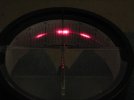Hi all,
I've got a goniometer that aids in determining the angle at which a knife has been sharpened. It works quite well for knives with a flat grind, as for example my Swamprat Ratmandu:

The edge has got an angle of about 20 degrees per side.
It also works quite well for thin knives with a convex grind, However, I cannot interpret the results the goniometer gives for a thick knife with a convex grind, my Fallkniven A1:

Can you help me interpret what my goniometer tries to tell me?
Thanks!
I've got a goniometer that aids in determining the angle at which a knife has been sharpened. It works quite well for knives with a flat grind, as for example my Swamprat Ratmandu:

The edge has got an angle of about 20 degrees per side.
It also works quite well for thin knives with a convex grind, However, I cannot interpret the results the goniometer gives for a thick knife with a convex grind, my Fallkniven A1:

Can you help me interpret what my goniometer tries to tell me?
Thanks!

